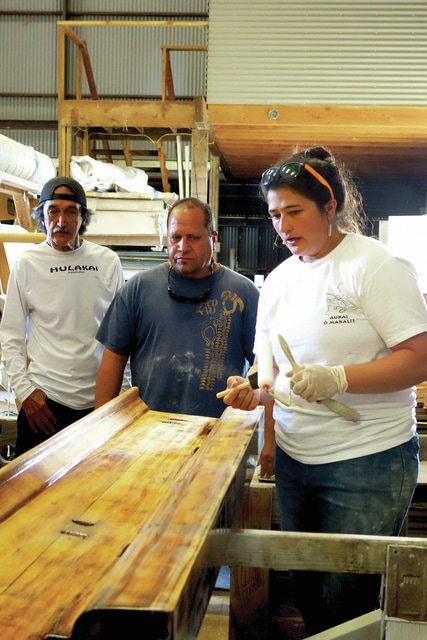The theater lobby was filled with participating school staff and students, community groups, community members and crew members and their families. With the call of the pu we gathered chanting “Malana Mai Kau” as we made our way into the auditorium, led by cultural practitioner Pua Case.
The voyage is a focal point of the Hanauna Ola (To Sustain the Generations) program, funded through a 2016 Administration for Native Americans grant. The idea for the program was inspired by a question asked by Chadd Paishon eight years ago: “Can our island provision one canoe as our ancestors did?” Looking to the past and into the future, the Hanauna Ola program, whose purpose is to restore and perpetuate cultural practices that support our island community’s physical, spiritual, and psychological health and well-being, was the catalyst that energized 10 school gardens and five community groups into action.
The canoe crew met for regular trainings with Pwo Navigator, Shorty Bertelmann to learn the many skills involved in sailing the canoe, including non-instrument navigation, which all crew members learned. “There were 50 crew members trained, representing all the districts on this island, Kauai, Molokai and every generation from the very beginning of Makalii’s voyages,” said Lehua Ah Sam, Na Kalai Waa staff member.
Bertelmann’s choice of Mokumanamana as a destination grew from a desire to discover the origins of the ancestors. There is evidence that Mokumanamana could be where the first Polynesians began their migratory path to Hawaii Island.
“We want to try and take a look at Mokumanamana, to look back to our past to find out more about who we are. Aunty Pualani Kanaka’ole Kanahele will be on board. She has done research over the last 10 years to gain ancestral, cultural, scientific knowledge that we can pass on to our children,” said Bertelmann.
The “land crew” was an essential element to the success of the program. “We went island-wide and asked: Would you be willing to be on board with this? And they all said yes and threw everything they had into it,” said program coordinator, Keala Kahuanui.
Coordinated by Paishon and Kahuanui, the land crew worked together to grow and preserve food that will provision the 14-person rotating canoe crew for the 30-day voyage. Not only did the school gardens grow the food, but they also learned techniques for food processing and preservation such as dehydration, freeze-drying, pickling and canning.
“We put 16 pounds of ulu (breadfruit) in the dehydrator and we came out with four pounds. For a cook on the waa, that is just amazing,” said Kahuanui.
The results have been stunning with a variety of creative and delicious foods to sustain the crew on their voyage, a sampling of which is on display in the Kahilu Theater lobby as part of the Waimea Educational Hui’s art exhibit.
But Hanauna Ola goes beyond provisioning the canoe. “With Hanauna Ola, we can put food on the shelves and feed the kids. The schools are doing it in that sense beyond the voyage. That's the exciting thing. Young kids can create things and feed their own families with what they create,” said Paishon.
The other focus area for the land crew is cordage which literally and metaphorically connects everything together. Crews learned about growing and processing hau, hala, niu and laʽi. “The cordage connects our moku, our waa and our kupuna (elders) islands together, but these tools, these skill sets will be applied beyond the voyage,” said Kahuanui.
Hanai waa, the third component of the program means to foster, sustain and connect and it is that spirit that was very much present at the gathering. At the heart of hanai waa voices are raised in chant, a conduit to the deep spirit that connects everything and is the manner in which voices are sent out on the wind when a canoe leaves the shores. “Chanting is huge, an integral part of everything that we do. A chant might ask permission for a canoe to begin its journey, announce the arrival of a canoe to the welcoming land base, or recite the genealogy of its creation. Hanai waa is to chant with all your heart with a complete understanding of the intention and purpose,” said Case.
Kahuanui calls out the names of the people who have contributed their time and efforts over the last three years to be acknowledged. The celebration is infused with joyous chanting as the crew and their family gather on the stage, voices flow, meet and connect.
The Hanauna Ola program has glimpsed the past to move on into the future. The Polynesian voyagers accomplished the amazing feat of crossing the Pacific Ocean to discover and settle the most isolated land mass on earth through the combined efforts of the community and when they made landfall those principles enabled them to thrive.
Now we have Makalii to teach us what we need to do for a sustainable future for generations to come. Hanauna Ola may have been a three-year program, but it has become a way of life and will continue on in our island communities.














 RSS Feed
RSS Feed
